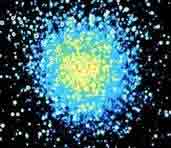|
> Classification of Stellar Spectra
|
We have discovered a large amount of information about stars, about their birth, life and their death.. Star, large celestial body composed of gravitationally contained hot gases emitting electromagnetic radiation, especially light, as a result of nuclear reactions inside the star. The Sun is a star. With the sole exception of the Sun, the stars appear to be fixed, maintaining the same pattern in the skies year after year. In fact the stars are in rapid motion, but their distances are so great that their relative changes in position become apparent only over the centuries.
The number of stars visible to the naked eye from Earth has been
estimated to total 8,000, of which 4,000 are in the northern hemisphere of
the sky and 4,000 in the southern hemisphere. At any one time during the
night in either hemisphere, only about 2,000 stars are visible. The others
are obscured by atmospheric haze, especially near the horizon, and by
faint sky light. Astronomers have calculated that the stars in the
Milky
Way, the galaxy to which the
Sun belongs, number in the hundreds of
billions. The Milky Way, in turn, is only one of several hundred million
such galaxies visible through large modern telescopes. The individual
stars visible in the sky are simply those that lie closest to the solar
system in the Milky Way.
|
